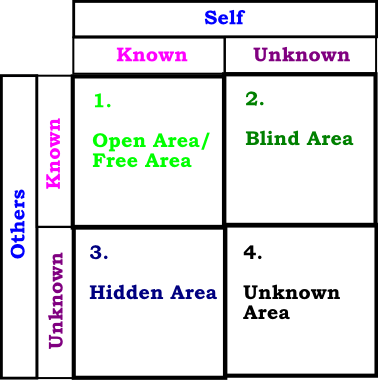In this article “Personality Development and The Johari Window” we are discussing about all quadrants of ‘The Johari Window’ based on Personality Development.
The Johari Window
When we talk about self-awareness, personality development, group development or team development, we must know about ‘The Johari window’. So, first, here we are discussing about ‘The Johari window’.
‘The Johari window’ model was developed by American psychologists Joseph Luft and Harry Ingham in 1950’s. Combining first letters of their names Jo and Hari, it is called as Johari. This model is also known as disclosure / feedback model of self-awareness.
‘The Johari Window’ model talks about two sides of observation ‘self’ and ‘others’. Here ‘self’ refers to person subjects to The Johari Window analysis. The term ‘others’ refers to other people in the team or group or related to the person. All the information related to the analysis are observed on two sides, ‘self’ and ‘others’. The information includes views, skills, attitudes, experience, motivation etc. related to a person. You can read the factors that affect personality development in our article “Factors Affecting Personality Development“.
Some areas are known and other are unknown to person as well as others. The Johari Window Model consists of four regions (or areas) on the basis of known and unknown areas of ‘self’ and ‘others’ as shown in figure below.

Personality Development and The Johari Window
In this section we will just discuss about all the four quadrants or areas. As we already discussed, the areas represent known and unknown areas of ‘self’ and ‘others’. The information includes views, skills, attitudes, experience, motivation etc. related to a person.
1. Open Area / Free Area
Open / Free area represents what is known by the person about him / herself and to others. If this area is more, the person is more open, having good communication and transparent. This area shows how much he / she is able to work in the group. The development of open / free area is possible by extending it to both sides. That is by opening up our hidden areas to others and also by getting feedback from others to reduce the area we don’t know about us.
2. Blind Area
This area represents what is unknown by the person about him / herself but others know. This area tells something about self-awareness, that is how much he knew about himself. If someone ignores self, he / she will have more blind area. For developing personality, one should reduce this area. That is possible by getting feedback from others. Your mentor, coach, teacher, relatives, friends, etc. have great role in reducing this area.
3. Hidden Area
This area represents what the person knows about him / herself that others do not know. Hidden area for a person will be more if he / she is having hidden agenda, fears, less communication skills, etc. A person can reduce this area by increasing proper communication. This can be possible by improving and developing skills.
4. Unknown Area
Unknown area represents what is unknown by the person about him / herself and is also unknown by others. Collective efforts of self and others will be effective in reducing this area. Efforts must be taken by persons with the help of mentors or coach to improve in this area.
Conclusion
A person who wants to develop personality must focus on expanding open area, and reduce other three areas by different methods.
You may also like to visit our page Personality Development for more articles.

